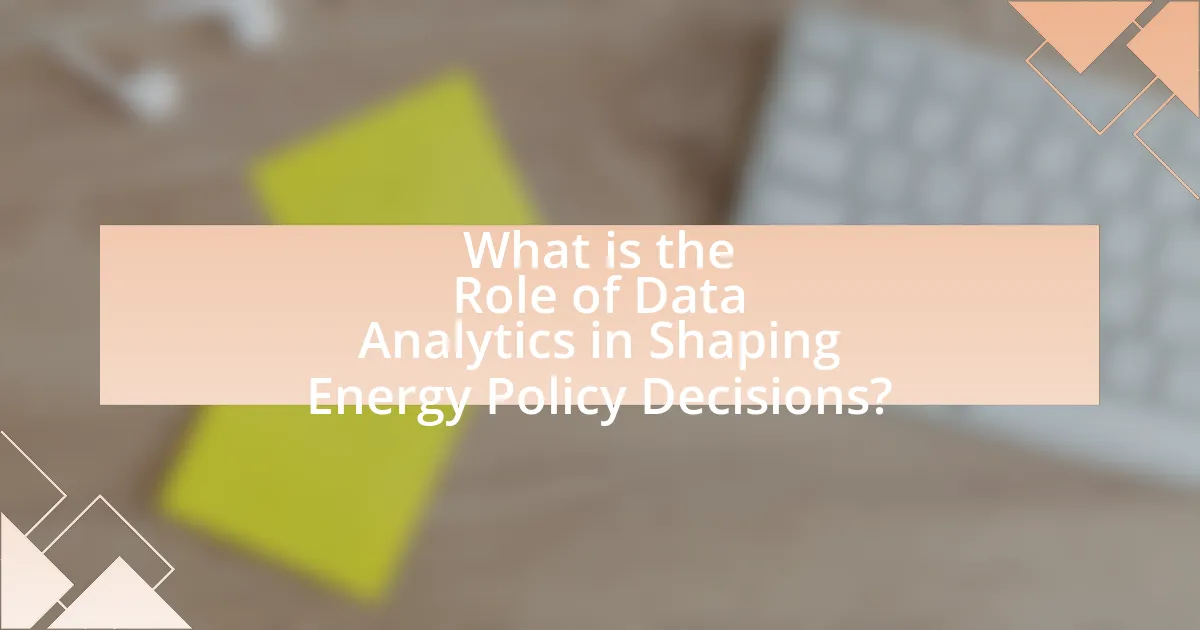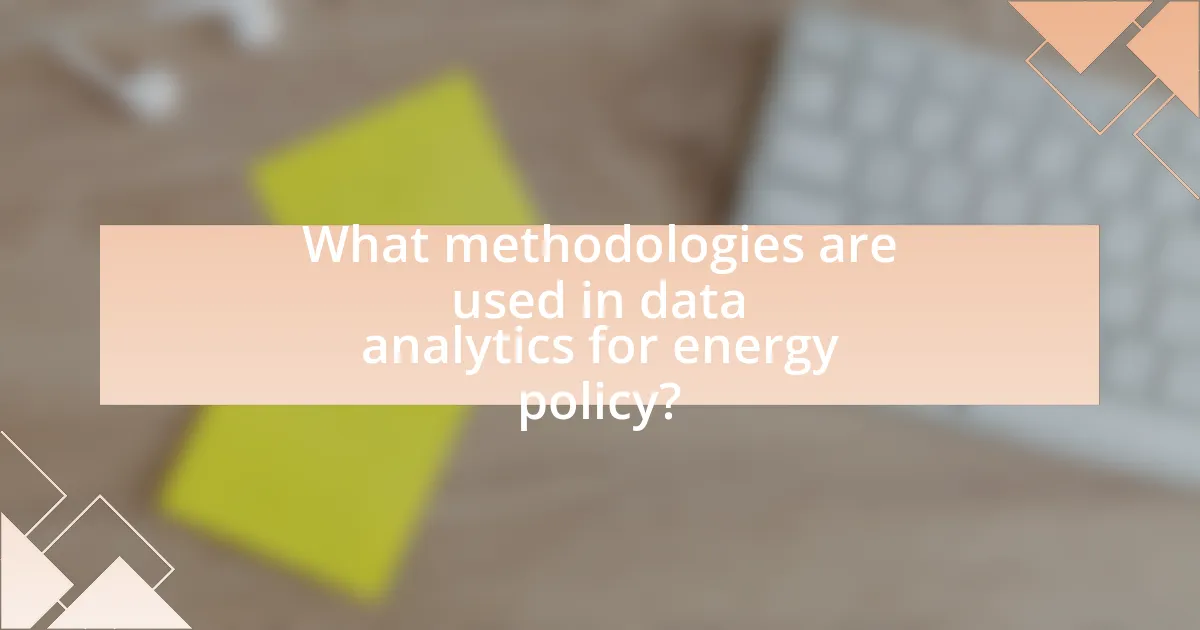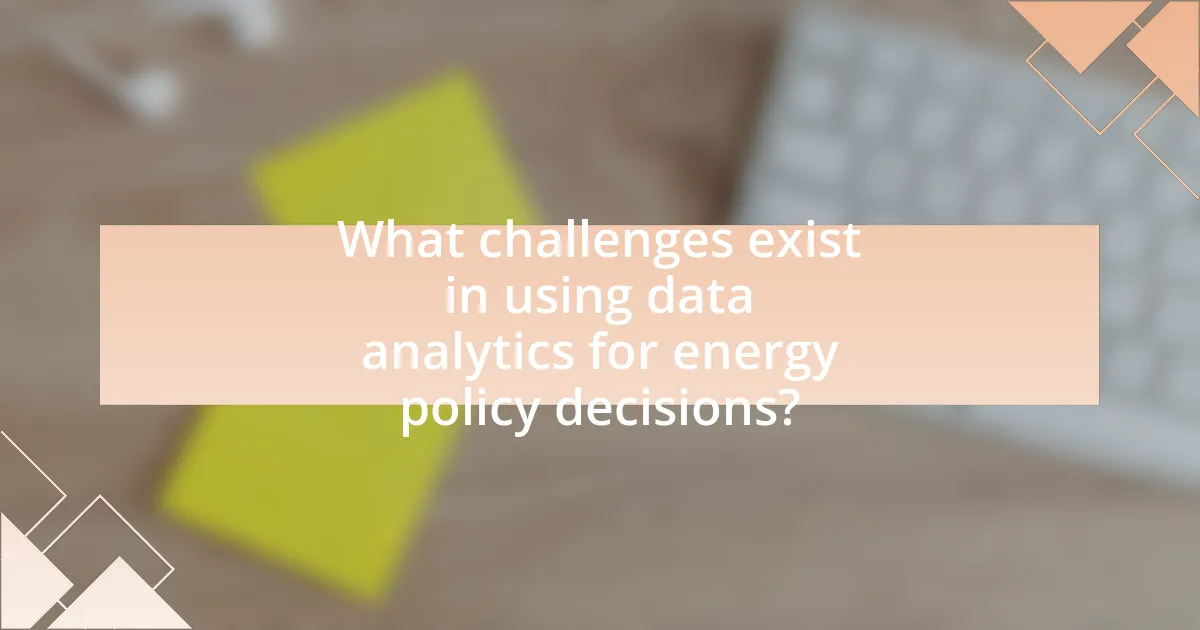Data analytics is a critical component in shaping energy policy decisions, providing data-driven insights that enhance strategic planning and regulatory frameworks. The article explores how data analytics influences energy policy formulation by identifying consumption trends, assessing renewable energy impacts, and evaluating existing policies. It discusses relevant data types, collection methods, and analytical methodologies, highlighting the benefits of improved decision-making and resource allocation. Additionally, the article addresses challenges such as data quality and integration, ethical considerations, and future trends in technology that will further influence energy policy development.

What is the Role of Data Analytics in Shaping Energy Policy Decisions?
Data analytics plays a crucial role in shaping energy policy decisions by providing data-driven insights that inform strategic planning and regulatory frameworks. Through the analysis of large datasets, policymakers can identify trends in energy consumption, assess the impact of renewable energy sources, and evaluate the effectiveness of existing policies. For instance, the International Energy Agency reported that data analytics can enhance energy efficiency by up to 30%, enabling governments to make informed decisions that promote sustainability and reduce carbon emissions. By leveraging predictive modeling and scenario analysis, data analytics helps in forecasting future energy demands and optimizing resource allocation, ultimately leading to more effective energy policies.
How does data analytics influence energy policy formulation?
Data analytics significantly influences energy policy formulation by providing data-driven insights that inform decision-making processes. Through the analysis of large datasets, policymakers can identify trends in energy consumption, assess the impact of renewable energy sources, and evaluate the effectiveness of existing policies. For instance, a study by the International Energy Agency (IEA) highlighted that data analytics enables governments to optimize energy efficiency programs by analyzing usage patterns and forecasting future demand, leading to more effective resource allocation. This empirical evidence demonstrates that data analytics is essential for developing responsive and adaptive energy policies that align with both economic and environmental goals.
What types of data are most relevant for energy policy analysis?
The types of data most relevant for energy policy analysis include energy consumption data, production data, economic indicators, environmental impact data, and demographic data. Energy consumption data provides insights into usage patterns and trends, while production data reveals the sources and amounts of energy generated. Economic indicators, such as energy prices and market trends, inform policy decisions regarding energy investments and subsidies. Environmental impact data assesses the ecological consequences of energy production and consumption, which is crucial for sustainable policy development. Demographic data helps understand the energy needs and behaviors of different population segments, allowing for targeted policy measures. These data types collectively enable comprehensive analysis and informed decision-making in energy policy.
How is data collected and processed for energy policy decisions?
Data for energy policy decisions is collected through various methods, including surveys, sensor data, satellite imagery, and administrative records. These data sources provide quantitative and qualitative insights into energy consumption patterns, resource availability, and environmental impacts.
Once collected, data undergoes processing through statistical analysis, machine learning algorithms, and modeling techniques to identify trends and forecast future energy needs. For instance, the U.S. Energy Information Administration utilizes data from energy producers and consumers to generate reports that inform policy decisions.
This systematic approach ensures that policymakers have access to accurate and relevant information, enabling them to make informed decisions that align with energy efficiency and sustainability goals.
Why is data analytics essential for effective energy policy?
Data analytics is essential for effective energy policy because it enables informed decision-making through the analysis of vast amounts of energy-related data. By utilizing data analytics, policymakers can identify trends, forecast energy demand, and evaluate the impact of various energy sources on the environment and economy. For instance, a study by the International Energy Agency found that data-driven insights can lead to a 20% reduction in energy consumption by optimizing resource allocation and improving efficiency. This demonstrates that data analytics not only supports the development of targeted energy policies but also enhances the overall effectiveness of energy management strategies.
What are the key benefits of using data analytics in energy policy?
The key benefits of using data analytics in energy policy include improved decision-making, enhanced efficiency, and better resource allocation. Data analytics enables policymakers to analyze vast amounts of energy consumption data, identify trends, and forecast future energy needs, which leads to more informed and effective policy decisions. For instance, a study by the International Energy Agency found that data-driven insights can reduce energy consumption by up to 20% in certain sectors, demonstrating the tangible impact of analytics on energy efficiency. Additionally, data analytics facilitates the integration of renewable energy sources by optimizing grid management and predicting supply fluctuations, ultimately supporting a transition to sustainable energy systems.
How does data analytics improve decision-making in energy sectors?
Data analytics improves decision-making in energy sectors by providing actionable insights derived from large datasets, enabling organizations to optimize operations and enhance efficiency. For instance, predictive analytics allows energy companies to forecast demand patterns, which can lead to better resource allocation and reduced operational costs. According to a report by the International Energy Agency, implementing data analytics can increase operational efficiency by up to 20%, demonstrating its significant impact on decision-making processes. Additionally, data analytics facilitates real-time monitoring of energy consumption, allowing for immediate adjustments and strategic planning based on current trends and anomalies.

What methodologies are used in data analytics for energy policy?
Data analytics for energy policy employs methodologies such as statistical analysis, machine learning, and simulation modeling. Statistical analysis helps in understanding historical energy consumption patterns and forecasting future trends, while machine learning algorithms can identify complex relationships in large datasets, enabling predictive analytics for energy demand and supply. Simulation modeling, including tools like Monte Carlo simulations, allows policymakers to evaluate the impact of different energy policies under various scenarios. These methodologies are validated by their application in real-world energy policy decisions, such as the use of predictive models in the California Independent System Operator’s grid management, which has improved energy efficiency and reliability.
What analytical techniques are commonly applied in energy policy analysis?
Common analytical techniques applied in energy policy analysis include cost-benefit analysis, scenario modeling, and econometric modeling. Cost-benefit analysis evaluates the economic feasibility of energy policies by comparing the costs and benefits associated with different energy options. Scenario modeling allows policymakers to explore various future energy pathways and their implications, helping to assess risks and uncertainties. Econometric modeling uses statistical methods to analyze historical data and forecast future trends in energy consumption and production, providing insights into the potential impacts of policy changes. These techniques are essential for informed decision-making in energy policy, as they enable a systematic evaluation of options and outcomes.
How do predictive analytics contribute to energy policy development?
Predictive analytics significantly contribute to energy policy development by enabling data-driven decision-making that enhances efficiency and sustainability. By analyzing historical energy consumption patterns, predictive models can forecast future energy demands, allowing policymakers to allocate resources effectively and plan for infrastructure needs. For instance, a study by the International Energy Agency found that predictive analytics can improve energy efficiency by up to 20% in urban areas by optimizing grid management and reducing waste. This data-driven approach not only supports the creation of more effective energy policies but also aligns with environmental goals by promoting renewable energy sources and reducing carbon emissions.
What role does machine learning play in energy data analysis?
Machine learning plays a crucial role in energy data analysis by enabling the extraction of insights from large and complex datasets. It facilitates predictive modeling, which helps in forecasting energy demand and optimizing resource allocation. For instance, machine learning algorithms can analyze historical consumption patterns to predict future energy needs, thereby assisting utilities in managing supply effectively. According to a study by the International Energy Agency, the integration of machine learning in energy systems can improve efficiency by up to 20%, demonstrating its significant impact on operational decision-making and policy formulation in the energy sector.
How do stakeholders utilize data analytics in energy policy?
Stakeholders utilize data analytics in energy policy to inform decision-making, optimize resource allocation, and enhance regulatory compliance. By analyzing large datasets, stakeholders can identify trends in energy consumption, forecast demand, and evaluate the impact of various policies on energy efficiency and sustainability. For instance, the U.S. Energy Information Administration employs data analytics to provide insights on energy production and consumption patterns, which helps policymakers craft informed regulations. Additionally, utilities use predictive analytics to manage grid operations and integrate renewable energy sources effectively, demonstrating the practical application of data analytics in shaping energy policy.
What are the perspectives of government agencies on data analytics?
Government agencies view data analytics as a crucial tool for enhancing decision-making and policy formulation. They recognize that data analytics enables the identification of trends, patterns, and insights that inform energy policy decisions. For instance, the U.S. Department of Energy has implemented data analytics to optimize energy consumption and improve grid reliability, demonstrating its commitment to leveraging data for effective energy management. Additionally, government agencies utilize data analytics to assess the impact of energy policies, ensuring that decisions are evidence-based and aligned with sustainability goals.
How do private sector companies leverage data analytics for energy policy?
Private sector companies leverage data analytics for energy policy by utilizing advanced analytical tools to optimize energy consumption, forecast demand, and enhance operational efficiency. For instance, companies like Google and Microsoft analyze vast datasets to improve energy management in their data centers, resulting in energy savings of up to 40%. Additionally, firms employ predictive analytics to assess the impact of regulatory changes on energy markets, enabling them to adapt strategies proactively. This data-driven approach not only supports compliance with energy policies but also drives innovation in sustainable practices, as evidenced by the increasing investments in renewable energy technologies that are informed by data insights.

What challenges exist in using data analytics for energy policy decisions?
Using data analytics for energy policy decisions faces several challenges, including data quality, integration issues, and the complexity of energy systems. Data quality is critical, as inaccurate or incomplete data can lead to flawed analyses and misguided policies. Integration issues arise when combining data from diverse sources, which may have different formats and standards, complicating the analytical process. Additionally, the complexity of energy systems, characterized by numerous variables and interdependencies, makes it difficult to model and predict outcomes accurately. These challenges hinder the effective use of data analytics in formulating sound energy policies.
What are the limitations of data analytics in energy policy formulation?
Data analytics in energy policy formulation has several limitations, including data quality issues, lack of comprehensive datasets, and the challenge of interpreting complex data. Data quality issues arise from inaccuracies, inconsistencies, and gaps in the data collected, which can lead to misleading conclusions. Additionally, the absence of comprehensive datasets limits the ability to analyze all relevant factors affecting energy policy, such as socio-economic variables and environmental impacts. Furthermore, interpreting complex data requires specialized skills and knowledge, which may not be readily available among policymakers, potentially leading to oversimplified or erroneous policy decisions. These limitations highlight the need for careful consideration and validation of data analytics in the energy policy formulation process.
How do data quality and availability impact energy policy decisions?
Data quality and availability significantly influence energy policy decisions by providing accurate and timely information necessary for effective planning and implementation. High-quality data enables policymakers to assess energy needs, evaluate the impact of existing policies, and forecast future energy demands, which is crucial for sustainable development. For instance, the International Energy Agency emphasizes that reliable data on energy consumption patterns and renewable energy potential is essential for formulating effective energy strategies. Conversely, poor data quality can lead to misguided policies, resulting in inefficient resource allocation and increased costs. Therefore, the integrity and accessibility of data directly shape the effectiveness of energy policies.
What ethical considerations arise from data analytics in energy policy?
Ethical considerations in data analytics for energy policy include privacy concerns, data accuracy, and the potential for bias. Privacy concerns arise when personal data is collected and analyzed, potentially infringing on individual rights. Data accuracy is critical, as incorrect data can lead to misguided policies that affect energy distribution and consumption. Additionally, bias in data analytics can result in unfair treatment of certain populations, particularly if algorithms favor specific demographics over others. For instance, a study by the National Renewable Energy Laboratory highlights that biased data can lead to inequitable energy access, emphasizing the need for ethical frameworks in data usage.
How can the effectiveness of data analytics in energy policy be improved?
The effectiveness of data analytics in energy policy can be improved by integrating real-time data collection and advanced predictive modeling techniques. Real-time data allows policymakers to respond swiftly to changing energy demands and supply conditions, while predictive modeling enhances the ability to forecast future trends based on historical data. For instance, the integration of Internet of Things (IoT) devices in energy systems has been shown to provide granular data that can inform more accurate policy decisions. A study by the International Energy Agency in 2021 highlighted that countries utilizing real-time analytics saw a 15% increase in energy efficiency. This demonstrates that leveraging advanced analytics tools can lead to more informed and effective energy policies.
What best practices should be adopted for data analytics in energy policy?
Best practices for data analytics in energy policy include ensuring data quality, integrating diverse data sources, employing advanced analytical techniques, and fostering collaboration among stakeholders. Ensuring data quality involves validating and cleaning data to enhance accuracy, as poor data can lead to misguided policy decisions. Integrating diverse data sources, such as energy consumption patterns, environmental impact data, and economic indicators, allows for a comprehensive analysis that reflects the multifaceted nature of energy systems. Employing advanced analytical techniques, including machine learning and predictive modeling, can uncover insights and trends that traditional methods may overlook. Finally, fostering collaboration among government agencies, private sector entities, and academic institutions promotes knowledge sharing and innovation, which are crucial for developing effective energy policies. These practices are supported by studies indicating that data-driven decision-making significantly improves policy outcomes in the energy sector.
How can collaboration enhance data analytics efforts in energy policy?
Collaboration can enhance data analytics efforts in energy policy by facilitating the sharing of diverse datasets and expertise among stakeholders. When government agencies, private companies, and academic institutions work together, they can combine their resources to create more comprehensive and accurate models for energy consumption, production, and environmental impact. For instance, the U.S. Department of Energy has partnered with various universities and research organizations to analyze energy data, leading to improved forecasting and policy recommendations. This collaborative approach not only increases the volume and variety of data available but also fosters innovation through the integration of different analytical techniques and perspectives, ultimately leading to more effective energy policies.
What are the future trends in data analytics for energy policy?
Future trends in data analytics for energy policy include the increased use of artificial intelligence and machine learning to optimize energy consumption and improve predictive modeling. These technologies enable policymakers to analyze vast datasets, leading to more informed decisions regarding energy efficiency and renewable energy integration. For instance, the International Energy Agency reported that AI applications could reduce global energy demand by up to 10% by 2030. Additionally, real-time data analytics will enhance grid management and facilitate the transition to decentralized energy systems, allowing for better demand response and energy storage solutions.
How will advancements in technology shape data analytics in energy policy?
Advancements in technology will significantly enhance data analytics in energy policy by enabling more accurate modeling, real-time data processing, and improved predictive analytics. For instance, the integration of artificial intelligence and machine learning allows for the analysis of vast datasets from smart grids and IoT devices, leading to better forecasting of energy demand and supply. According to a report by the International Energy Agency, the use of advanced analytics can reduce energy consumption by up to 15% through optimized resource allocation and demand response strategies. Furthermore, blockchain technology can enhance transparency and security in energy transactions, facilitating more informed policy decisions. These technological advancements collectively empower policymakers to make data-driven decisions that promote sustainability and efficiency in energy systems.
What emerging data sources could influence future energy policy decisions?
Emerging data sources that could influence future energy policy decisions include real-time energy consumption data from smart meters, satellite imagery for monitoring renewable energy potential, and social media analytics to gauge public sentiment on energy issues. Smart meters provide granular data on energy usage patterns, enabling policymakers to tailor energy programs effectively. Satellite imagery allows for accurate assessments of solar and wind resources, informing investment in renewable infrastructure. Social media analytics can reveal public attitudes and concerns, guiding policymakers in addressing community needs and preferences. These data sources enhance decision-making by providing actionable insights and fostering a more responsive energy policy framework.
What practical steps can policymakers take to leverage data analytics effectively?
Policymakers can leverage data analytics effectively by implementing a structured approach that includes investing in data infrastructure, fostering collaboration among stakeholders, and utilizing advanced analytical tools. Investing in data infrastructure ensures that high-quality, accessible data is available for analysis, which is crucial for informed decision-making. Collaboration among stakeholders, including government agencies, private sector partners, and academic institutions, enhances the sharing of insights and best practices, leading to more comprehensive policy development. Utilizing advanced analytical tools, such as predictive modeling and machine learning, allows policymakers to identify trends and forecast outcomes, thereby improving the accuracy of energy policy decisions. For instance, the International Energy Agency reported that countries employing data analytics in energy policy have seen a 20% improvement in energy efficiency outcomes.